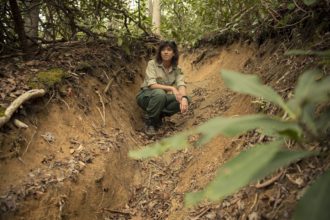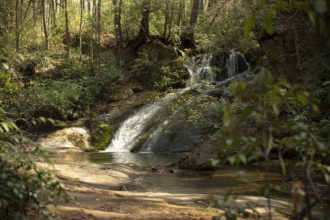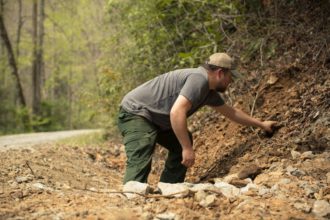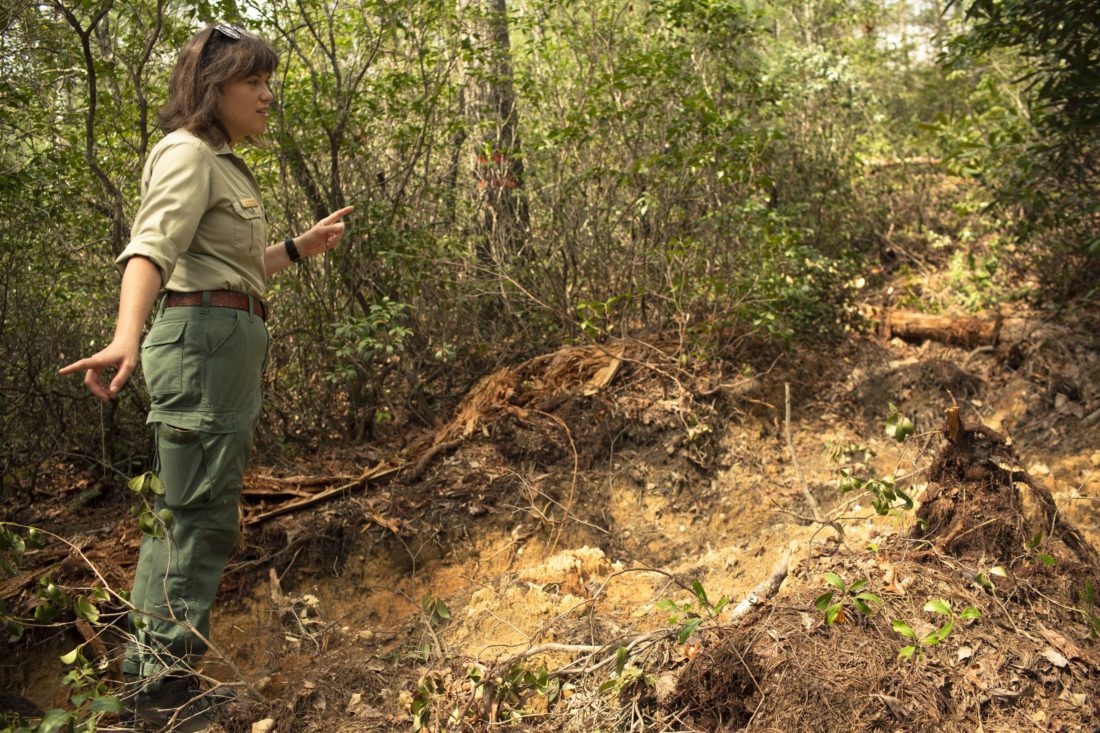By Jack Igelman, originally published by Carolina Public Press. Carolina Public Press is an independent, in-depth and investigative nonprofit news service for North Carolina.
Editor’s note: This article is part 4 of the five-part in-depth series Fraught Forests from Carolina Public Press, which examines the challenges of climate change for Western North Carolina’s mountain forests.
Big views, technical obstacles and thrilling descents are the calling cards of Western North Carolina’s extensive mountain biking trail system and why it’s known as one of the East Coast’s most revered destinations.
But climate change threatens to alter how mountain bikers play in the forest.
Nationwide, and in WNC, mountain biking is among the fastest-growing outdoor recreational activities.
The surge of trail ridership in the last decade has led to an assortment of complications, particularly at popular trail hubs within the area’s two national forests: Pisgah and Nantahala.
Scarce parking, muddy trails and crowded routes are some of the issues topping the list.
That’s presented new challenges to recreation workers, such as Lisa Jennings, recreation manager of Pisgah National Forest’s Grandfather Ranger District, to rethink how to manage trails.

Heavy ridership and trail demand are not new issues in the region. However, the mounting threat of impacts from climate change has made maintaining an environmentally sustainable trail system more perplexing and urgent.
“We’re trying to be proactive and make a resilient trail infrastructure across the forest before it gets to the point where you can’t use it,” she said.
In fact, within the last decade, Jennings said, the impact of weather has accelerated, evident on sections of some trails, such as the popular Schoolhouse Ridge Trail in Caldwell County.
Over time, surface water from rainfall and an abundance of riders carved deep convex grooves running down sections of some trails.
So deep are ruts in some parts, their perimeter forms walls of dirt taller than Jennings.
“During a heavy rain, water would literally run from the top of the mountain, down the trail and into the road and through a culvert into the creek,” she said.
This year, the U.S. Forest Service, in cooperation with the Northwest North Carolina Mountain Bike Alliance, relocated and redesigned 1.5 miles of the Schoolhouse Ridge Trail. The redesigned trail recently reopened to the public.
The restoration work is part of the Mortimer Trails Project, which aims to improve the sustainability of the existing trail system and add 10 more miles of mountain biking and hiking trails.
The Mortimer trail complex — named for a bygone logging community — is in the Wilson Creek watershed in Avery and Caldwell counties.
The headwaters of the Wilson Creek watershed form on steep terrain below Grandfather Mountain along the eastern escarpment of the Blue Ridge Mountains.

Mountain biking in the area has much-desired technical and long backcountry riding opportunities that are scarce in the Eastern U.S.
In years past, the trails maintained a steady condition because of their relative difficulty and seclusion. Paths heal themselves as leaves and other debris layer the trail and protect it from erosion.
However, the trails in the Mortimer complex are more compacted and prone to runoff, leading to ecological damage. Heavier ridership interrupts the ability of trails to repair themselves, leaving them more vulnerable to erosion.
“We’re seeing busy trailheads across Western North Carolina every weekend,” Jennings said.
The Mortimer trail complex is relatively close to population centers in Charlotte, Raleigh and the Interstate 40 corridor, Jennings said.
“When they go west to the mountains, the Grandfather District is what they touch first,” she said.
Climate change and trails
Jennings explained that trails established decades ago tend to be randomly placed, lack design to meet user needs and are prone to erosion. A large portion of the system consists of legacy trails, that is, paths that follow remnants of bygone logging roads and old fire lines.
So, when storms hit Grandfather Mountain, its high ridge tends to capture relatively large amounts of rain. The runoff flows down several creeks and steep slopes that descend suddenly over several thousand feet in the Wilson Creek watershed.
Among the anticipated weather changes as a result of a warmer climate are more intense periods of rain interspersed with longer dry spells.
“The increased frequency and intensity of high-volume rainfall is the recipe for high impacts on our trails,” she said.

“Most of what we do in trail management is figuring out how to get the water off the trail. There was never a trail system designed for mountain biking. They weren’t designed with any of this in mind.”
However, the health and quality of forests are also crucial variables in the sustainability of trails.
As a consequence of the steep topography in the watershed and throughout Western North Carolina, the area is prone to flash floods. In 1916, for instance, remnants of two tropical weather systems devastated the area. The damage was heightened by intensive logging that left forests in poor condition.
Although protection of the forests following an era of industrial logging was surely an environmental victory, a consequence is a forest with large portions that are aging all at once.
Without regular disturbance, such as wind and fire, forests are less healthy.
In fact, ecological restoration is a central focus of the nearly complete Pisgah-Nantahala National Forest Land Management Plan, which has been more than a decade in development.
“What we want is a mosaic of age classes,” Jennings said. “Some regeneration, logging or natural disturbance is really going to benefit the forest. The diversity of forest types and ages makes it more resilient to climate change.”
A less diverse class of tree ages and species makes the forest more prone to catastrophic events, such as pests or intense fire seasons. For example, the hemlock woolly adelgid has wiped out vast portions of hemlocks, leaving streams without shade.
In the case of trails, healthy forests help manage the volume of water pouring down mountain ridges, particularly in the steep landscape of the Wilson Creek watershed.
“The landscape is forested now, but climate change is going to change the forest in ways that we can’t predict,” she said.
The Schoolhouse Ridge Trail carves through a pine-oak forest that’s common in the eastern escarpment of the Blue Ridge. The forest type includes a range of pine species, interspersed with hardwoods and an understory of mountain laurels. The forest plan rates the “pine oak heath ecozone” as a high priority restoration area that’s currently in “poor to fair” condition.
The soil here is dry, and fire is a necessary component of maintaining the forest’s health. Without fire or other timber management prescriptions, white pine and mountain laurel spread beyond their natural distribution.
In addition to the hazard of invasive pests, such as the Southern pine beetle and the woolly adelgid, the threat of extreme wildfire poses a serious concern.
The lack of fire on the landscape over decades has altered the distribution of vegetation; for example, mountain laurel has spread throughout the understory, so when wildfire strikes, it’s more intense, leading to a hazard.
The rapid spread of the fast-growing and dense mountain laurel becomes highly flammable, particularly during drought conditions, so that leaves and branches are parched.
Roots and organic matter hold soil in place, but heat from fires burns more vegetation and organic material deep in the soil. When heavy rainfall follows an intense wildfire, the consequences are deep gullies and landslides that gush soil into streams impacting aquatic ecosystems and water quality.
Collectively, runoff on trails throughout the watershed can “add up to a lot of sediment in the creek at once,” Jennings said.
“Most people understand that if you put too much water on your garden when it’s dry, it all runs off.”
Trade-offs
With more access to trails, better gear and the pandemic discouraging indoor recreation, mountain biking has experienced a swift rise in popularity.
The creation of “front country” mountain bike parks, such as the Ride Kanuga Mountain Bike Park in Flat Rock and Chestnut Mountain Park in Canton, will help absorb some of the rider base, Kristian Jackson said. Jackson is a lecturer at Appalachian State University and a trail builder who helped design and build the Schoolhouse Ridge Trail among other sections of trails throughout the region.
However, plenty of riders still crave the archetypal primitive trail experience of Pisgah National Forest: big climbs, epic descents, rocks, roots and an abundance of technical obstacles.

That viewpoint is evident in mountain biker online chat rooms where riders quibble over the issue with remarks that Pisgah “lost its soul” and its uniqueness erased by bland trail design.
Yet the gravity that mountain bikers crave is also one of the reasons the trails are not sustainable.
But what takes precedence: the user experience or the environment? Is there a way to preserve riders’ expectations while making a trail sustainable?
“The question really comes down to what makes a technical trail,” Jackson said.
“I’m advocating to change our understanding of what a technical trail is, in which stewardship is in the forefront just as much as shredding.”
Jennings views trails as nonpermanent structures on the forest landscape.
Like a forest, road or footpath, they change over time, along with the way people use them. Several decades ago, bikers weren’t part of the user landscape; now they are among the biggest and most impactful users.
“We are thinking about building a permanent structure, but trails aren’t permanent,” she said. “People’s patterns move over time. So, I view our trail system as something that changes over time and has to be adaptive.”
Some portions of the new Schoolhouse trail follow the original line, but with modifications. For example, the redesigned trail swoops around a curve and down a steep switchback with a wide vertical berm at its side.
Since more soil on the berm side is exposed to runoff during storms, water is routed off the trail into a drain — a small ditch at the side of the trail — to disperse sediment from the trail into the forest, where it’s absorbed by vegetation.
While some trails may be unsustainable, Jennings said, over time with management, they can mitigate the problems and keep them ridable.
“Unsustainable but manageable,” she said
Yet, at a cost of roughly $30,000 per mile of trail, according to Jennings, the 10-mile addition in the Mortimer trail complex is a big step for the strapped federal agency that hasn’t prioritized funding for recreation over the last several years.
But with a slim budget, the Forest Service intends to lean on partners to maintain, improve and add more trail miles to accommodate the recreation boom. It’s also important that people love the trails.
“What happens in 20 years, when I’m not here, and the volunteers all grow older?” she asked. “What if nobody maintains it?”
This is why it’s vital to build trails that people love. The better their experience, the more likely they are willing to maintain them.
Meanwhile, since Schoolhouse opened, Jackson has “heard nothing but accolades” for their work but recognizes that plenty of riders are skeptical of new trail design replacing the raw classic Pisgah rides.
“Stewardship is a principle that can’t really be chipped away at, in my opinion,” Jackson said. “Those folks will eventually come around. Water always wins.”




Before you comment
The comments section is here to provide a platform for civil dialogue on the issues we face together as a local community. Xpress is committed to offering this platform for all voices, but when the tone of the discussion gets nasty or strays off topic, we believe many people choose not to participate. Xpress editors are determined to moderate comments to ensure a constructive interchange is maintained. All comments judged not to be in keeping with the spirit of civil discourse will be removed and repeat violators will be banned. See here for our terms of service. Thank you for being part of this effort to promote respectful discussion.